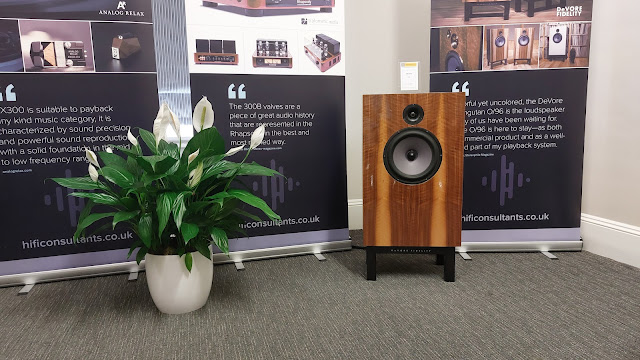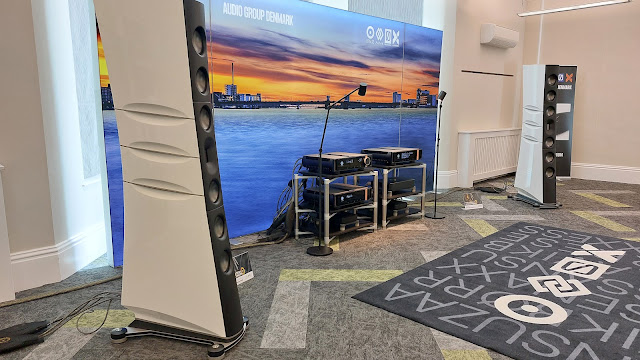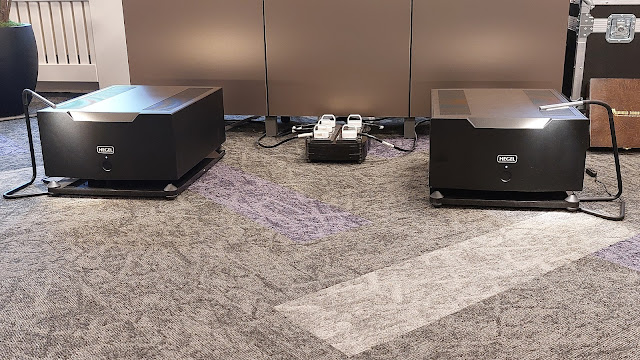What's an active loudspeaker?
A passive loudspeaker has a power amplifier connected to a set of components inside the speaker cabinet that separate the music frequencies between the drivers. These components are unpowered and sap power from the musical signal - typically they need to be quite large components to cope with the power flowing through them which leads to lower levels of accuracy in their manufacture and performance.
Done properly, like this option from PMC, an active loudspeaker means a set of powered crossover components fed from a pre-amplifier which send the split signal to a power amplifier dedicated to each driver in the loudspeaker. The powered crossover components deal with low power signal levels so can be manufactured more accurately and better quality crossover designs are possible. Sometimes the powered crossover and power amplifiers are external to the speaker, sometimes internal and in the case of the PMC Twenty5 and Twenty5i conversion they're a module which fits into the back of the cabinets, directly replacing the standard passive crossover panel.
Above I say "done properly" because some manufacturers (usually in lower priced products) call a loudspeaker active when really its just powered by an internal amplifier that drives a standard passive crossover.
So what are PMC up to with active modules in the Twenty5 and Twenty5i speakers? The first of the Twenty series speakers were called just that - the Twenty range and they were launched to celebrate 20 years of the company. In the domestic audio market I would say that this was the range of speakers that turned PMC from a respected but relatively little known manufacturer into a much higher volume well known brand. Five years later they launched a replacement range called Twenty5 which had different cabinets across the board and then a couple of years ago these were tweaked into the Twenty5i range.
The Twenty5i range consists of a very small 2-way standmount 21, a large 2-way standmount 22, a slim floorstanding 2-way 23, a larger floorstanding 2-way 24 and the range topping (far more impressive as a performer) 3-way 26. More details at PMC.
What's in the box?
There are 2 options here - you can buy a Twenty5i 21, 22, 23 or 24 speakers with the active module already fitted into the speaker in place of the passive crossover, or, if you already have Twenty5, 21, 22, 23 or 24 or Twenty5i 21, 22, 23 or 24 passive speakers you can buy the active module to be retrofitted by the dealer. If buying a brand new speaker the active version is approx. £1500 more than the passive equivalent. As a retro fit to an existing speaker the cost is around £1800.
Note that only 2-way speakers are currently covered by the active module. The Twenty5 and Twenty5i 26 3-way speakers and the C centre channel are not included at the moment (even though the C is a 2-way design - I would speculate that there isn't room in that cabinet). It seems that there's no current plan to add these models.
Demo
In the interests of transparency, I've not been a fan of the Twenty / Twenty5 / Twenty5i models with the smaller bass driver - ie the 21 and 23 models, even though its the 23 that's the mainstay of sales.
The demo system featured 2x pairs of Twenty5i 23. Front end source was a Linn Selekt DSM streamer with the Organik stereo DAC module (approx £10k). Output from this was fed to an ATC CDA2 combined CD player / pre-amp acting as a pre-amp (approx £3k). The passive version of the speakers were driven by a Linn Akurate 2200 stereo power amp (approx £3.4k).
Our host played 3 tracks on the passive system - "Hey Laura" by Gregory Porter, "Here Comes The Sun (2019 version)" by The Beatles and "Happiness Is Easy (12" Mix)" by Talk Talk. Resolution is good, bass weight is fine for the size of the speaker but it feels a little "lazy". This is the main characteristic of the 23 models that I find to criticise - it just doesn't boogie, the music doesn't drive the along the way you might hope for a £4.5k speaker. Vocals are nicely resolved and have the emotion you'd hope for but are a little polite and recessed in the mix.
We get the first couple of minutes of Talk Talk again and then we swap from the passive system to the active system - the speakers now being directly connected to the pre-amp and the Linn Akurate power amp gets to rest a while. The speakers were positioned in the same marked location in the room (more on this later) and we went straight back to Talk Talk. It only takes half the track to hear the differences the active conversion brings. Everything is much more clearly presented - treble is tidier - bass is fuller and vocals stand clearly in the mix. Any downsides? Probably not. The only downside we discussed between us was that perhaps the bass was a little too full - to be fair it would probably be worth experimenting with room positioning as this is a significant system change at play. Remember here that we're looking at replacing a £3.4k power amp with a £1.8k active module. That's not to say the Linn is a poor amplifier, its a testament to how fundamental it is to move the crossover from sapping power in passive mode to replacing it with far more accurate circuits in front of the power amp. And I've saved the most important change to last - each driver has its own power amp and they are connected directly together - no power sapping passive components getting in the way. And that will be part of the biggest improvement this option brings - the starting and stopping of the notes is in a different league, as is the impression of the music driving along - there's pace, dynamics and enthusiasm. But its not aggressive nor wearing - we listened to another hour's worth of music and it was far more enjoyable - foot tapping in action. It made a big difference to enjoyment of the music.
Conclusion
So no hesitation in saying this is a significant improvement on passive - and in this comparison, significantly better value for money.
Oh, and I've now heard a 23 I can enjoy :)
Thanks are due to Rob and Phil at Adventures in Hifi, Chester for the demo. I'm sure they'll be happy to offer a similar demo for you.










































































